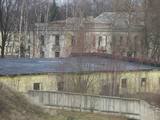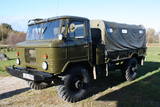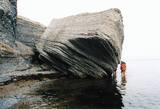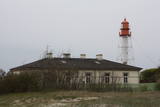| Nr | Nosaukums | Apraksts |
|---|---|---|
|
Netālu no Rīgas apvedceļa Daugavas labajā krastā atrodas 1994. g. atklātais un tēlnieka Ģ. Burvja veidotais piemineklis - piemiņas zīme. Veltīts Daugavas lībiešiem un viņu Mārtiņsalas vadonim – lībietim Ako, kas 1206. gadā vadīja cīņu pret krustnešiem. Pieminekļa apkaimē gar Daugavas krastu izveidota plaša atpūtas un pastaigu vieta. Šī ir viena no ainaviskākajām vietām Daugavas lejteces krastos. Mazliet tālāk upes krastā izvietoti informatīvi stendi, kas atspoguļo Daugavas krastu vēsturi pirms Rīgas HES izbūves. |
||
|
Tagadējā Daugavgrīvas cietokšņa vietā pirmo nocietinājumu 1608.gadā poļu-zviedru kara laikā uzbūvēja zviedru armija. 17.gs. četrdesmitajos gados zviedru armija šeit uzbūvēja modernu cietoksni ar pieciem bastioniem un diviem vārtiem. Te bija izvietoti 120 lielgabali un mortīras, zaldātu kazarmas, virsnieku dzīvokļi, garnizona baznīca, pārtikas un munīcijas noliktavas. Ziemeļu kara rezultātā 1710.gadā cietoksnis nonāca Krievijas armijas rokās. Arī pēc Latvijas okupācijas 1940.gadā šeit izvietojās PSRS Jūras Kara flotes vienības. Diemžēl, bet unikālais vēstures piemineklis, kas atrodas valsts galvaspilsētā šobrīd publiski nav pieejams. Ļoti aptuvenu priekstatu par to var gūt, apskatot no ārpuses, kur redzami mūri, bastioni, cietokšņa grāvis un neliela daļa no vecās baznīcas. Blakus cietoksnim atrodas bijušā PSRS armijas daļa ar pamestām ēkām un pieminekli karavīriem, kas dienējuši zemūdenēs. Cietoksnis publiskai apskatei pieejams sestdienās, svētdienās no plkst. 10.00 līdz 16.00. |
||
|
Atrodas 0,1 km uz dienvidiem no Grobiņas pilsdrupām, Grobiņas ūdenskrātuves (Ālandes upes uzpludinājums) labajā krastā. Sens kuršu pilskalns, pie kura konstatētas senpilsētas paliekas. Vēsturiskie avoti liecina, ka 1263. g. kurši pili bez cīņas atdeva Livonijas ordeņa bruņiniekiem nodedzināšanai. Grobiņa ir viena no vecākajām Latvijas apdzīvotajām vietām, jo laikā no 7. - 9. gs. (pēc citiem avotiem: 4. – 10. gs.) te atradusies lielākā zināmā skandināvu tirgotāju un karavīru kolonija tagadējās Baltijas teritorijā. Gotlandes un Zviedrijas ieceļotāji apmetni ierīkoja tajā laikā kuģojamās Ālandes upes labā krasta pakalnā – Skābaržkalnā. Uzskata, ka tieši šeit atradusies 9. gs. hronikās pieminētā kuršu Jūrpils (Seeburg). Vietvārda (Skābaržkalns) izcelsmi saistīta ar pilsētas nosaukumu, jo Kurzemē skābaržus savulaik dēvēja par grobiem. Pie pilskalna novietota informatīva zīme. Ar otru Ālandes krastu to savieno neliela koka pārceltuve. |
||
|
Viesu mājas Pūpoli saimnieks Edgars Kārklevalks ar paša iegādātu un atjaunotu Padomju armijas kravas automašīnu GAZ – 66 piedāvā doties vēsturiski izzinošā braucienā pa Ziemeļkurzemi, maršrutā iekļaujot bijušās militārās teritorijas.
|
||
|
Šis ir viens no 6 ceļojuma maršrutiem sērijā "Baudi laukus!", un tas aicina apmeklēt Lauku Labumus – visdažādāko veidu un nozaru saimniecības un uzņēmumus, kas atvērti apmeklētājiem, piedāvā ekskursijas, nogaršot, apskatīt un iegādāties savus ražojumus. Tur apskatāmi mājdzīvnieki, mūsdienīgas lauku saimniecības, amatnieku darbnīcas, iegādājami lauku produkti – maize, medus, mājas vīns un alus, siers, ogas, augļi, zivis, gaļa, dārzeņi, tējas un citi laukos audzēti labumi. Pa ceļam iespējams ieturēt pusdienaslauku krodziņos. |
||
|
Mākslinieka Jāņa Roņa izlolotā Piebalgas Porcelāna Fabrika ir vienīgā porcelāna ražotne Latvijā. Sākotnēji tika izveidota Porcelāna mākslas galerija Vecrīgā, darbnīca Kalnciema ielā un apgleznošanas studija Majoru kultūras namā. 2007. gadā aizsākas porcelāna ražošana Piebalgā, un šobrīd „baltais zelts” kļuvis par vienu no Piebalgas simboliem. Nelielā ražotne bijušajā Vecpiebalgas pienotavas ēkā attīstījusies par veiksmīgu uzņēmumu ar zīmolu Piebalgas Porcelāna Fabrika, kas ar neparastiem un oriģināliem mākslas priekšmetiem ieinteresējusi gan Latvijas, gan ārzemju tirgus. Rūpīgs roku darbs rada smalkus traukus, suvenīrus un īpašas dāvanas. Apmeklētāji aicināti paviesoties ražotnē, izzināt trauslā porcelāna tapšanas noslēpumu un izmēģināt porcelāna apgleznošanu. |
||
|
Saimniecība nodarbojas ar kaņepju audzēšanu un produktu izstrādāšanu vecajā Aizputes Pilsmuižas krogā, kas atrodas blakus Aizputes Livonijas ordeņa pilsdrupām. |
||
|
Saimniecības plašos laukus gādīgu bitenieku uzraudzībā ‘’apsaimnieko’’ ~ 150 bišu saimes. Te audzē arī nektāraugus – griķus, amoliņu, facēliju. Bišu saimes noslēpumu izzināšana, biškopības produktu izbaudīšana un iegāde. |
||
|
Tāšu – Padures muiža (Tasch – Paddern) celta 19. gs. sākumā kā Korfu dzimtas pils, kas 1852. gadā pāriet Keizerlingu dzimtas īpašumā kā medību pils, kas kalpojusi kā vasaras mītne, un ir izcils vēlīnā klasicisma paraugs. Iekštelpās saglabājušies vairāki senā interjera apdares fragmenti. Pēc pils pabeigšanas, ap to sāka veidot vairāk kā 10 ha lielu parku ar svešzemju kokiem. Šobrīd muižas ēkā atrodas Kalvenes pamatskola. |
||
|
Bauskas vārds vēstures avotos pirmo reizi minēts 1443. g. Tas ir laiks, kad pussalā starp Mūsas un Mēmeles sateku uzsāka pēdējās Livonijas ordeņa pils celtniecību tagadējās Latvijas teritorijā. Pie pils – Ķirbaksalā - izveidojās apdzīvota vieta t.s. Vairogmiests. 17. gs. bija vērojams straujš pilsētas uzplaukums. Te darbojās zeltkaļi, sudrabkaļi, galdnieki, podnieki, kurpnieki un citi amatnieki. Vēlākajos gadsimtos pilsētnieki cieta no kariem, mēra un Napaleona armijas. Mūsdienās Bauskas vecpilsēta ar tikko kā no jauna uzcelto Rātsnamu un atjaunoto Bauskas pili ir viens no interesantākajiem Latvijas pilsētu vēsturiskajiem centriem. Bauska ir pazīstama ar saviem ikgadējiem pasākumiem - Senās mūzikas festivālu, Bauskas pilsētas svētkiem, Kantri mūzikas festivālu u.c. pasākumiem. |
||
|
Talsu vecpilsētā, pašā vēsturiskā centra vidū, atrodas īpaša vieta, kur saplūst lauku miers un pilsētas dzīvīgums. Te vari izbaudīt gan klusumu un nesteidzīgu atmosfēru, gan arī sajust tuvumā esošo ielu dzīves ritmu. Šī māja ir kā radīta romantiskam nedēļas nogales atpūtam divatā — vakarā iekurt kamīnu, iemirdzināt telpu sveču gaismā un baudīt siltu vīna glāzi klusā divvientulībā. Tajā pašā laikā tā lieliski piemērota arī ģimenēm vai draugu kompānijām, kas vēlas pavadīt laiku kopā ērtā un plašā vidē. Villā pieejamas piecas guļamistabas, divas vannas istabas, kvalitatīva gultas veļa un dvieļi, satelīttelevīzija plakanajā ekrānā, ērta ēdamzona, pilnībā aprīkota virtuve, kā arī terase ar skatu uz dārzu. Papildus ērtībām viesiem ir atpūtas zona un kamīns, kas lieliski papildina vietas mājīgumu. |
||
|
Atrodas Ventspils Rātslaukuma rietumu pusē iepretim Nikolaja luterāņu baznīcai. Ēkas pirmsākumi ir meklējami 18. gs. 1850. g. tajā atradās pilsētas Rātsnams, kopš 2006. g. - rakstnieku un tulkotāju māja, kurā patstāvīgi uzturas un strādā Latvijas un ārvalstu literāti. |
||
|
Divas salas – Lielā Pakri (Suur Pakri) un Mazā Pakri (Väike Pakri) - 3 km R no Paldiskiem (Paldiski). Padomju laikā tās izmantoja kā armijas aviācijas poligonu, par ko liecina daudzās bumbu bedres un munīcijas paliekas. Salas klāj g.k. retas kadiķu audzes, bet to Z, ZA galos paceļas iespaidīgas līdz 6 m augstas kaļķakmens klintis.
|
||
|
Zemnieku saimniecība „Lejas Kleperi” atrodas Smiltenes novadā. Saimniecības zemes kopplatība ir 119,4ha t.sk. meži 86,1ha. Saimniecības pamatnodarbošanās saistīta ar meža apsaimniekošanu. Kopš 1992. gada vienā no dzīvojamām ēkām uzsākta zemkopības un mežkopības instrumentu privāta muzeja veidošana. Muzeja eksponātu klāsts tiek nemitīgi papildināts. |
||
|
Padomju laikā visas bākas bija militāra statusa objekti, arī Papes bāka. Šobrīd bāku apsaimnieko Latvijas Jūras administrācija un tā ir apskatāma tikai no ārpuses.
|
||
|
Atrodas Talsu centrā, tirdzniecības centra „Talsu centrs” trešajā stāvā. Moderns, mūsdienīgs interjers. |
||
|
Sudrabkalni – bijusī aptieka, līdz pagājušā gadsimta astoņdesmito gadu
beigām – ambulance, vēlāk – pamatskola, tagad – privātmāja.
|
||
|
Atrodas Katedrāles ielā 1. Ķemeru vecākā baznīca celta 1893. g. Ziemeļkrievijas koka baznīcu arhitektūras formās (arhitekts V. Lunskis). Pie dievnama apglabāti 1. pasaules karā kritušie 97 krievu karavīri, kuriem 1925. g. atklāts piemineklis - melns marmora krusts. Netālu no baznīcas meklējami 2. pasaules karā kritušo un pēc kara no ievainojumiem mirušo padomju karavīru brāļu kapi un piemineklis. Šī ir senākā Ķemeru baznīca. Pēc nostāstiem tā ir celta bez nevienas naglas. Baznīcā var ieiet dievkalpojumu laikā, taču apmeklētājiem jābūt atbilstoši ģērbtiem! Pārējā laikā ēka apskatāma no ārpuses. |
||
|
Gaisa trošu ceļš pār Gauju ir Baltijas valstīs vienīgais šāda veida objekts un arī transporta līdzeklis. To cēla 1969. g. sadarbībā ar Gruzijas inženieriem. Gaisa tramvaju nesošā trose stiepjas 1060 m garumā un bez atbalstiem savieno Gaujas senlejas krastus starp Siguldu un Krimuldu ~ 40 m augstumā virs upes līmeņa. No Gaisa tramvaja paveras viena no labākajām Gaujas senlejas ainavām! Vakaros šo unikālo objektu izmanto gumijlecēji. |
||























